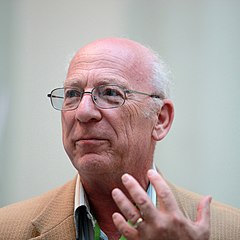
Summary
Barry M. Trost (born June 13, 1941, in Philadelphia) is an American chemist who is the Job and Gertrud Tamaki Professor Emeritus in the School of Humanities and Sciences at Stanford University.[1] The Tsuji-Trost reaction and the Trost ligand are named after him. He is prominent for advancing the concept of atom economy.[2][3]
Barry Martin Trost | |
|---|---|
 Barry M. Trost in June 2012 | |
| Born | June 13, 1941 (age 82) |
| Nationality | American |
| Alma mater | University of Pennsylvania B.S. (1963) Massachusetts Institute of Technology Ph.D. (1965) |
| Known for | Tsuji-Trost reaction, Trost ligand, Atom economy |
| Awards | ACS Award in Pure Chemistry (1977) Ernest Guenther Award (1990) William H. Nichols Medal (2000) Arthur C. Cope Award (2004) The Ryoji Noyori Prize (2013) Linus Pauling Award (2015) |
| Scientific career | |
| Fields | Organic Chemistry |
| Institutions | University of Wisconsin–Madison Stanford University |
| Thesis | The Structure and Reactivity of Enolate Anions (1965) |
| Doctoral advisor | Herbert O. House |
| Doctoral students | Brian Coppola Michael J. Krische F. Dean Toste |
Early life and education edit
Trost was born in Philadelphia, Pennsylvania on June 13, 1941. He studied at the University of Pennsylvania and obtained his B.A. in 1962.[4] He then attended the Massachusetts Institute of Technology for graduate school, where he worked with Herbert O. House on enolate anions, the Mannich reaction, and the Robinson annulation.[5][6][7] Trost graduated with his Ph.D. in 1965.
Independent career edit
Trost moved to the University of Wisconsin–Madison to begin his independent career, and was promoted to professor of chemistry in 1969, and the Vilas Research Professor in 1982.[4] In 1987, he moved to Stanford University as professor of chemistry, and was appointed the Job and Gertrud Tamaki Professor of Humanities and Sciences in 1990. He previously served as chair of the department of chemistry.[4]
As of 2021[update], Trost has an h-index of 161 according to Google Scholar[8] and of 140 (1040 documents) according to Scopus.[9]
Research edit
Trost's research focused on chemical synthesis.[10] In order to build complex target molecules from simple molecules, Trost developed new reactions and reagents, and utilized cascade reactions and tandem reactions.[10] Target molecules have potential applications as novel catalysts, as well as antibiotic and anti-tumor therapeutics.[11]
References edit
- ^ "Barry Trost | Department of Chemistry". chemistry.stanford.edu. Retrieved May 24, 2021.
- ^ Trost, Barry M. (1991). "Atom Economy: A Search for Synthetic Efficiency". Science. 254 (5037): 1471–1477. Bibcode:1991Sci...254.1471T. doi:10.1126/science.1962206. PMID 1962206.
- ^ Trost, Barry M. (1995). "Atom Economy - A Challenge for Organic Synthesis: Homogeneous Catalysis Leads the Way". Angewandte Chemie International Edition. 34 (3): 259–281. doi:10.1002/anie.199502591.
- ^ a b c Trost, Barry M.; Toste, F. Dean; Pinkerton, Anthony B. (June 19, 2001). "Non-Metathesis Ruthenium-Catalyzed C−C Bond Formation". Chemical Reviews. 101 (7): 2067–2096. doi:10.1021/cr000666b. ISSN 0009-2665. PMID 11710241.
- ^ House, Herbert O.; Trost, Barry M. (June 1, 1964). "The Mannich Reaction with 2-Methylcyclopentanone and 2-Methylcyclo hexanone1a". The Journal of Organic Chemistry. 29 (6): 1339–1341. doi:10.1021/jo01029a016. ISSN 0022-3263.
- ^ House, Herbert O.; Trost, Barry M. (May 1, 1965). "The Chemistry of Carbanions. IX. The Potassium and Lithium Enolates Derived from Cyclic Ketones1". The Journal of Organic Chemistry. 30 (5): 1341–1348. doi:10.1021/jo01016a001. ISSN 0022-3263.
- ^ House, Herbert O.; Trost, Barry M.; Magin, Ralph W.; Carlson, Robert G.; Franck, Richard W.; Rasmusson, Gary H. (August 1, 1965). "By-products of the Robinson Annelation Reaction with Cyclohexanone, Cyclopentanone, and Cyclopentane-1,2-dione1". The Journal of Organic Chemistry. 30 (8): 2513–2519. doi:10.1021/jo01019a004. ISSN 0022-3263.
- ^ Barry Trost publications indexed by Google Scholar
- ^ "Scopus preview – Trost, Barry M. – Author details – Scopus". www.scopus.com. Retrieved October 17, 2021.
- ^ a b "Trost Group Home". Stanford University. March 30, 2017. Retrieved October 17, 2021.
- ^ "Barry Trost". Department of Chemistry. Retrieved October 17, 2021.
Sources edit
- Biographical Data at Trost's Home Page
External links edit
- Barry Trost publications indexed by Google Scholar


